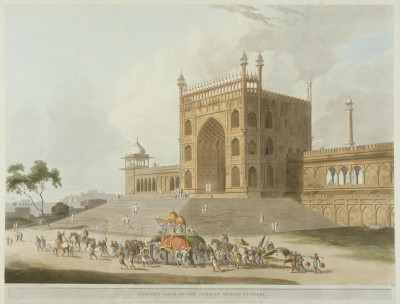Artist of the month: February 2016
Artist of the month: February 2016
Thomas Daniell RA
By The RA Collections Team
Published 1 February 2016
Thomas Daniell RA is best known for his images of the Indian subcontinent. More widely travelled than any of his colonial artist counterparts, he earned the nickname of “artist-adventurer”.
-
In 1784, Daniell received permission from the East India Company to embark on a journey through India, accompanied by his nephew William Daniell RA (1769–1837; pictured). Due to increased British military presence in India, they were the first artist travellers to India able to travel through all three of the Company Presidencies – Calcutta, Madras (now known as Chennai) and Bombay. As a result of these pioneering tours, Daniell gathered a huge visual inventory of the landmark cities, monuments, hill-forts and cave temples of the British territories in India.
As artists of the Romantic picturesque, travelling and capturing the most visually striking sites deemed to be of national interest, accurate and exact representation was of utmost importance. Daniell would use a camera obscura to take a view of the whole site, and a perambulator to measure its spaces. In William’s account of their visit to the Taj Mahal, he describes how they “spent the whole day at the Taj Mahal. Uncle drew the view from the Garden in the camera…” (pictured).
Throughout their travels, their goal of depicting India with such accuracy and exactitude meant that they often travelled in difficulty, in order to reach remote areas. They covered large distances by foot, rode in palanquins, ox-carts and on horseback, in journeyed in small boats by sea. Daniell increasingly looked for places and subjects that would appear the most “exotic” and unusual to British eyes. This search for the “singular” or uncommon element was a key aspect of theories of the picturesque.
-

George Dance RA, Portrait of Thomas Daniell RA, 1800.

Richard Westall RA, Portrait of William Daniell, 1800.
-
They created pencil sketches, often colour-washed. Some of the most successful and attractive scenes were worked up into fully finished watercolours. Later on, those scenes that particularly appealed were chosen as the subjects for oil paintings, such as Daniell’s work, Hindoo Temples at Bindrabund (pictured).
On their return to England in 1794, the two artists began to make a series of engravings from the wealth of material they had brought back with them. Between 1795 and 1808 they produced Oriental Scenery, a publication of six volumes containing a total of 144 hand-coloured aquatint views of India. Intended to be a comprehensive and panoramic survey of British India of the moment, the complete set was originally sold for 220 guineas, and was so successful that they produced a smaller quarto edition of the same subjects. When the engravings for Oriental Scenery where published in London, they were praised for their scientific accuracy and faithful representation. The series remains one of the finest and most influential sets of illustrations on India and, to a great extent, inspired the 19th-century fashion for Indian-inspired architecture, such as the grand country house and landscape gardens of Sezincote in Gloucestershire.
-

Thomas and William Daniell, The Taje Mahel, at Agra.

Thomas and William Daniell, Eastern Gate of the Jummah Musjid at Delhi.

Thomas Daniell RA, Hindoo Temples at Bindrabund, East Indies, 1797.
-
February’s object of the month is Basil Beattie RA’s Never Before (2001). Find out more about the RA Collection.








